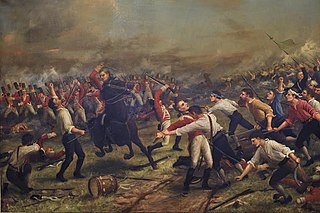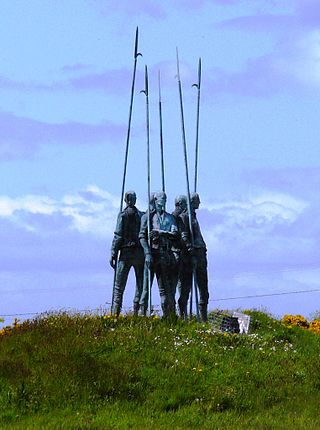Background
News of the outbreak of the rebellion to the north had filtered down to County Wexford and was accompanied by the arrival of two military regiments notorious for their brutality: the Royal North Cork Militia and a Welsh fencible cavalry unit known as the Ancient Britons. In addition, regular yeomanry patrols of the countryside and reports of a massacre of prisoners by yeomen in Carnew added to the atmosphere of widespread fear. As a consequence, many people banded together to watch for military patrols or abandoned their homes to hide in the countryside.
One such group, numbering about forty, were gathered by Father John Murphy near the village of The Harrow on the evening of 26 May. Ostensibly the men had come to cut turf for Father Murphy, their local curate, which was a custom at the time. This ruse allowed the men to carry turf cutters, which could serve as rudimentary weapons, but they also had a small number of firearms concealed nearby.
The Fight at The Harrow
Meanwhile, a patrol of about twenty yeomen (belonging to the Camolin Cavalry) were approaching, alerted by the reports of rebellion and seeking a number of suspected United Irishmen. The yeomen initially passed Fr. Murphy's group without incident, but the bulk of the patrol halted nearby while their commanding officer, a Lieutenant Bookey, together with a private, John Donovan, rode on ahead to the dwelling of one of the suspected United Irishmen. Finding their target was not at home, they set fire to the cabin and then turned back to rejoin their unit. The rebels attacked the yeomanry, killing Bookey and Donovan; the remainder of the patrol fled.
The official version of events was recorded in the entry for 26 May 1798 in the Detail Book of the Camolin Cavalry;
"On arrival in Ferns, Lieut. Smith and a party was ordered towards Scarawalsh, where the murders were committed, to see if this information was true, and Lieut. Bookey with another Party rode towards the Harrow, where he met a large party of Insurgents armed with Pikes and some Arms. The Lieut. rode before the Party, and ordered the rebels to surrender, and deliver up their Arms, on which they discharged a volley at the Party, accompanied with a shower of stones, some of which brought Lieut. Bookey from his horse, as also John Donovan, a private in the Corps. The party after firing a few shots, finding themselves overpowered by the Rebels, retreated to Ferns, where they remained ‘till day break, melancholy spectators of the devastation committed by the Rebels. The information of the Murders at Scarawalsh found to be true."

The Irish Rebellion of 1798 was a popular insurrection against the British Crown in what was then the separate, but subordinate, Kingdom of Ireland. The main organising force was the Society of United Irishmen. First formed in Belfast by Presbyterians opposed to the landed Anglican establishment, the Society, despairing of reform, sought to secure a republic through a revolutionary union with the country's Catholic majority. The grievances of a rack-rented tenantry drove recruitment.

The Battle of Vinegar Hill was a military engagement during the Irish Rebellion of 1798 on 21 June 1798 between a force of approximately 13,000 government troops under the command of Gerard Lake and 16,000 United Irishmen rebels led by Anthony Perry. The battle, a major rebel defeat, took place on 21 June 1798 on a large rebel camp on Vinegar Hill and in the streets of Enniscorthy, County Wexford and marked the last major attempt by the rebels to hold and control territory taken in Wexford.

The Battle of Oulart Hill took place on 27 May 1798 when a rebel gathering of between 4,000 and 5,000 annihilated a detachment of 110 militia sent from Wexford town to stamp out the spreading rebellion in County Wexford.

The Battle of Tara Hill was fought on the evening of 26 May 1798 between British forces and Irish rebels involved in the Irish Rebellion of 1798, resulting in a heavy defeat for the rebels and the end of the rebellion in County Meath.
The Battle of Ballyellis on 30 June 1798 was a clash during the Irish Rebellion of 1798, between a surviving column of the dispersed Wexford rebel army and pursuing British forces which resulted in a victory for the rebels.

The second Battle of Arklow took place during the Irish Rebellion of 1798 on 9 June when a force of United Irishmen from Wexford, estimated at 10,000 strong, launched an assault into County Wicklow, on the British-held town of Arklow, in an attempt to spread the rebellion into Wicklow and to threaten the capital of Dublin.
Anthony Perry, known as the "screeching general" was one of the most important leaders of the United Irish Wexford rebels during the 1798 rebellion.
The Battle of Tubberneering took place during the Wexford Rebellion fought on 4 June 1798 between Crown forces and United Irish insurgents, at Tubberneering south of Gorey in the north of County Wexford. The rebels ambushed and routed the British.
The Battle of Antrim was fought on 7 June 1798, in County Antrim, Ireland during the Irish Rebellion of 1798 between British troops and Irish insurgents led by Henry Joy McCracken. The British won the battle, beating off a rebel attack on Antrim town following the arrival of reinforcements but the county governor, John O'Neill, 1st Viscount O'Neill, was fatally wounded.
The battle of Ovidstown was a military engagement between British Crown forces and United Irishmen rebels during the Irish Rebellion of 1798 near the town of Kilcock, County Kildare. Despite the initial failures experienced by the United Irishmen in County Kildare during the first months of the rebellion, the consolidation of government forces in the town of Naas and the priority given by the Dublin Castle administration to suppress the Wexford Rebellion in County Wexford meant that much of the county remained in rebel hands since the outbreak of the rebellion. Towns such as Prosperous and Clane were in rebel hands, while towns such as Maynooth, Kilcock and Kildare had been attacked and briefly occupied by the rebels. By 19 June, however, neighbouring County Meath had been judged sufficiently pacified to allow for government forces to be dispatched from that county into Kildare to recapture rebel-held territory.
The Dunlavin Green executions was summary execution of 36 suspected United Irishmen rebels in County Wicklow, Ireland by the Irish Yeomanry shortly after the outbreak of the rebellion of 1798. There are several accounts of the events, recorded at differing times and differing in detail.
James Corcoran was an Irish rebel leader who following the suppression of the United Irish insurrection of 1798, maintained a guerrilla resistance to the British Crown forces in counties Wexford and Kilkenny until his final defeat and death in 1804.

John Murphy was an Irish Roman Catholic priest of the Roman Catholic Diocese of Ferns, who is mainly remembered for his central role in the Irish Rebellion of 1798 in County Wexford, which is sometimes known as the Wexford Rebellion. He led the rebels to one of their initial victories over a government militia at Oulart Hill, and in the following weeks became one of the rebellion's main leaders.
Events from the year 1798 in Ireland.

"Boolavogue" is an Irish ballad commemorating the campaign of Father John Murphy and his army in County Wexford during the Irish Rebellion of 1798. It was composed by Patrick Joseph McCall in 1898, the centenary of the Rebellion.
The Camolin Cavalry was a mounted yeomanry unit drawn from the area around the village of Camolin, Wexford, Ireland. It was a part of this unit, commanded by Lieutenant Bookey, which encountered Father John Murphy's small band of rebels at The Battle of the Harrow in the parish of Kilcormick on the evening of 26 May 1798.

The Wexford Rebellion refers to the events of the Irish Rebellion of 1798 in County Wexford. From 27 May until 21 June 1798, Society of United Irishmen rebels revolted against British rule in the county, engaging in multiple confrontations with Crown forces. The most successful and destructive rising in all the counties of Ireland, United Irishmen rebels experienced a number of early successes in the county despite being seen as a relatively loyal county by the Dublin Castle administration due to a series of military victories. However, the tide soon turned against the United Irishmen in Wexford as Crown forces poured into the region, engaging in a brutal counterinsurgency which indiscriminately targeted suspected rebels and eventually suppressed all rebel activities in the county.

The Battle of Enniscorthy was a land battle fought during the Irish Rebellion of 1798, on 28 May 1798, when an overwhelming force of rebels assailed the town of Enniscorthy, County Wexford, which was defended only by a 300-strong garrison supported by loyalist civilians. On the previous day at nearby Oulart, several thousand rebels led by Fr John Murphy had massacred a detachment of the North Cork militia, amounting to 110 officers and men.
The Battle of Kilthomas took place on 27 May 1798 when combined Loyalist Forces defeated a gathering of several thousand rebels in the greater Ferns/Carnew area, in one of the primary actions of the rebellion in County Wexford. This occurred at the same time as the Battle of Oulart Hill in the east of the county.

Scarawalsh is a historical barony in northern County Wexford, Ireland.









